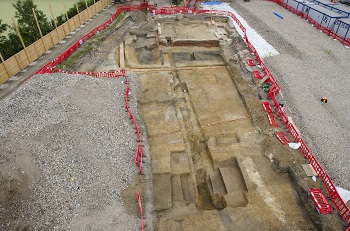Stepney Green (Crossrail XRV10)
Museum of London Archaeology, 2019. https://doi.org/10.5284/1055116. How to cite using this DOI
Data copyright © Museum of London Archaeology, Crossrail Ltd unless otherwise stated
This work is licensed under a Creative Commons Attribution 4.0 International License.
Primary contact
Karen
Thomas
Head of Archive
Museum of London Archaeology
Resource identifiers
- ADS Collection: 2874
- DOI:https://doi.org/10.5284/1055116
- How to cite using this DOI
Introduction

Stepney Green Shaft - Evaluation and Site monitoring exposed small prehistoric truncated features with very abraded late Bronze Age or Iron Age pot (not retained). There were NO Roman or earlier medieval finds. Substantial remains of Worcester House, including brick foundations of King John's Tower, a late 15th-c or 16th-c defensible gatehouse and ranges of rooms from the Tudor-Stuart Courtyard mansion, were also seen.
Stepney Green Shafts - Excavation and targeted watching briefs on Late-medieval and Tudor Common Sewer, Canalised round moated aristocratic manor house, converted to a baptist college in the early 19th century. TWB on remains of Congregational Church and attached school, 19th- and early 20th century houses and small factories. Significant finds include fine Tudor glassware, leather footwear and bowling ball and a medieval rowel spur.
Stepney Green shafts and Stepney City Farm watching briefs - A number of watching briefs on Stepney City Farm, and on an enlarged worksite area of the Crossrail shaft, exposed a series of walls and a culvert (in line with one found in 1970s) made from 2-inch thick bricks.
Further information about this site can be found in: Stepney Green: moated manor house to City Farm by David Sankey





